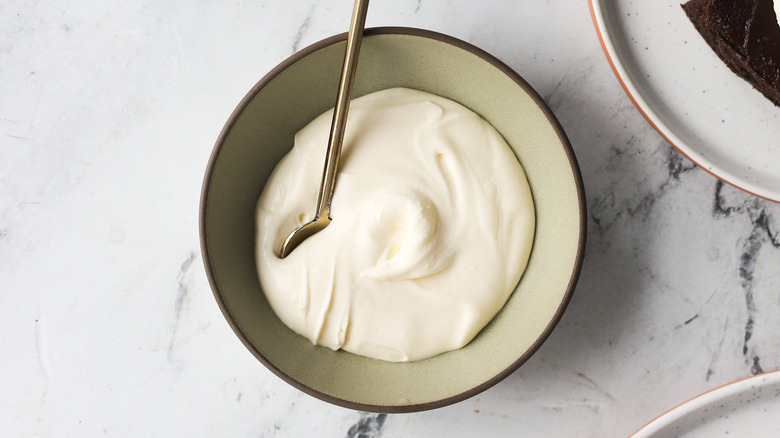If You Can't Find Crème Fraîche, Turn To Buttermilk And Heavy Cream
Chefs love crème fraîche, sour cream's rich cousin. Because of its slightly higher butterfat content, crème fraîche won't curdle in hot soups and sauces, and its brighter flavor provides more acid balance. When your next recipe calls for crème fraîche, you may have trouble finding it in the store. If you do find it, you might have some sticker shock — it can be expensive! Luckily, it's simple to make the creamy delicacy at home with easy-to-find buttermilk and heavy cream and a little advance planning.
Crème fraîche is literally a cream soured with a culture — in this case, the culture found in buttermilk. Heavy cream is essential, don't try to substitute half and half or a lighter cream. After all, it's the butterfat that makes crème fraîche a dream to cook with. Buttermilk contains active cultures of friendly microbes that will transform these dairy products into a thick tangy cream. Just like a sourdough starter brings flour and water to life, buttermilk is the key to attaining the flavor and texture of crème fraîche. A dash of citric acid can help to get the thickening to start and add an extra tang, but it's optional. You'll find citric acid with the canning supplies at your local store if you'd like to try it.
Cultural enrichment in the kitchen
Creating crème fraîche at home is even easier than making yogurt or kefir, though it's a very similar process. The milk for yogurt and kefir is warmed up before the culture is added to make the temperature right for the specific microbes needed to create these products. Crème fraîche will culture at room temperature with no additional heating steps — simply mix equal parts cream and buttermilk (add the citric acid if you want), stir, and wait. We recommend covering the container carefully to keep out dust or pests. After half a day, check to see if the mixture is thicker. When it has become the texture of thick yogurt, pop it in the refrigerator for 24 hours for the final thickening. During that time the crème fraîche will take on its lush texture and the tangy flavor will fully develop.
Why is it safe to leave that culturing cream on the counter all day? The bacteria in the buttermilk are converting the sugars in the cream to lactic acid, and that acid environment doesn't allow the bad bacteria to take over. Your homemade crème fraîche should last refrigerated for about 10 days, but discard it before that if there is any sign of mold or spoilage.

